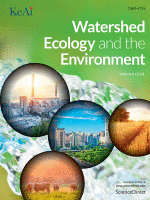Ver ítem
- xmlui.general.dspace_homeCentros e Institutos de InvestigaciónCIRN. Centro de Investigaciones de Recursos NaturalesInstituto de SuelosArtículos científicosxmlui.ArtifactBrowser.ItemViewer.trail
- Inicio
- Centros e Institutos de Investigación
- CIRN. Centro de Investigaciones de Recursos Naturales
- Instituto de Suelos
- Artículos científicos
- Ver ítem
Advancing wetland mapping in Argentina: a probalitistic approach integrating remote sensing, machine learning, and cloud computing towards sustainable ecosystem monitoring
Resumen
Wetlands, covering 7 % of Earth’s surface, are crucial for providing ecosystem services and regulating climate change. Despite their importance, global fluctuations in wetland distribution highlight the need for accurate and comprehensive mapping to address current and future challenges. In Argentina, a lack of detailed knowledge about wetland distribution, extent, and dynamics impedes effective conservation and management efforts. This study addresses
[ver mas...]
Wetlands, covering 7 % of Earth’s surface, are crucial for providing ecosystem services and regulating climate change. Despite their importance, global fluctuations in wetland distribution highlight the need for accurate and comprehensive mapping to address current and future challenges. In Argentina, a lack of detailed knowledge about wetland distribution, extent, and dynamics impedes effective conservation and management efforts. This study addresses these challenges by presenting a probabilistic wetland distribution map for Argentina, inte grating 20 years of satellite imagery with machine learning and cloud computing technologies. Our approach
introduces a comprehensive set of biophysical indices, enabling the identification of key wetland characteristics: 1) permanent or temporal surface water presence; 2) water-adapted vegetation phenology; and 3) geo morphology conducive to water accumulation. Our model achieved an accuracy of 89.3 %, effectively identifying wetland areas and delineating “elasticity” zones that reveal temporal wetland behavior. Approximately 9.5 % of Argentina is classified as wetlands, with the Chaco-Mesopotamia region accounting for 43 % of these areas. The performance of the 42 assessed variables varied across macro-regions, highlighting the necessity for regionspecific classification methods. In the Andean region, variables such as the Digital Elevation Model (DEM) and Topographic Wetness Index (TWI) were key predictors, while in the plains, spectral properties including vegetation and water content indices were more significant. Despite challenges in classifying irrigated areas, the model demonstrated considerable robustness. This study not only enhances our understanding of wetland dy namics but also provides insights into how different regions respond to various environmental factors, offering a more nuanced perspective on wetland behavior. These findings pave the way for refined conservation strategies and further research into the impacts of climate change and land use on wetland ecosystems. The precision, scalability, and representation of wetland elasticity emphasize its importance for decision-making and provide a crucial baseline for future research amid ongoing environmental changes.
[Cerrar]

Autor
Navarro, María Fabiana;
Calamari, Noelia Cecilia;
Navarro, Carlos Saúl;
Enriquez, Andrea Soledad;
Mosciaro, Maria Jesus;
Saucedo, Griselda Isabel;
Barrios, Raúl Ariel;
Curcio, Matías Hernán;
Dieta, Victorio;
Garcia Martinez, Guillermo Carlos;
Iturralde Elortegui, Maria Del Rosario Ma;
Michard, Nicole Jacqueline;
Paredes, Paula Natalia;
Umaña, Fernando;
Alday Poblete, Silvina Esther;
Pezzola, Nestor Alejandro;
Vidal, Claudia;
Winschel, Cristina Ines;
Albarracin Franco, Silvia;
Behr, Santiago Javier;
Cianfagna, Francisco A.;
Cremona, Maria Victoria;
Alvarenga, Fernando Agustin;
Perucca, Alba Ruth;
Lopez, Astor Emilio;
Miranda, Federico Waldemar;
Kurtz, Ditmar Bernardo;
Fuente
Watershed ecology and the Environment 7 : 144-158 (2025)
Fecha
2025-04-04
Editorial
Elsevier
ISSN
2598-4714
Documentos Relacionados
Formato
pdf
Tipo de documento
artículo
Proyectos
(ver más)
INTA/2019-PD-E2-I506-002, Humedales de la República Argentina: distribución, usos y recomendaciones coparticipativas para una producción sustentable
Palabras Claves
Derechos de acceso
Abierto
 Excepto donde se diga explicitamente, este item se publica bajo la siguiente descripción: Creative Commons Attribution-NonCommercial-ShareAlike 2.5 Unported (CC BY-NC-SA 2.5)
Excepto donde se diga explicitamente, este item se publica bajo la siguiente descripción: Creative Commons Attribution-NonCommercial-ShareAlike 2.5 Unported (CC BY-NC-SA 2.5)


